Color design in anime and manga makes up a huge part of the creative process, over 80%. It’s used strategically to show feelings, create atmosphere, and boost the story. All this shows just how important color is for these artists.
This article will uncover how pro anime and manga artists bring their works to life. We’ll look at color theory basics and how they master both digital and classic coloring. Join us to discover the magic of anime color design and manga color design. We’ll learn the secrets of their stunning and meaningful visuals that have won over fans globally.
Key Takeaways
- Anime and manga heavily rely on color theory to convey emotions, set mood, and highlight themes.
- Different colors are associated with specific traits and symbols in anime and manga artwork.
- Color contrast is a key technique used to emphasize important elements and create dramatic effects.
- Effective color schemes play a significant role in bringing characters to life and enhancing audience relatability.
- Color gradients and monochromatic schemes are utilized to create depth, set the mood, and highlight key elements.
Introduction to Color Design in Anime and Manga
In anime and manga, color is not just for looking nice. It’s a big part of telling stories and showing who characters are. Different colors can show how someone feels, where they are, and even what their personality is like.
The Role of Color in Storytelling
Warm colors like red, yellow, or orange make us feel passionate or happy. Meanwhile, muted, desaturated colors are used for sad or dark places like if the story is about tough times. For example, red might mean someone is brave or in danger, and blue often shows someone is smart or peaceful. Using bright colors against dark backgrounds is a trick to make certain things stand out more.
Difference Between Manga and Anime Coloring
Manga uses a smaller range of colors because it’s on paper. But anime has a lot more options because it moves and can use many techniques. Sometimes, to make everything look like it belongs together, they might use only one color in a scene. This can give a feeling of peace or show everyone is connected. Also, you might see a character’s colors change a little as they change through the story. This shows their growth.
Fundamentals of Color Theory
Learning about color theory for anime and manga is key for artists in these genres. The color wheel and shades of primary, secondary, and tertiary colors help create beautiful and strong artworks. Artists pick colors for stories, characters, and places using these principles.
Understanding the Color Wheel
The color wheel dates back to 1666 thanks to Sir Isaac Newton. It groups colors in a circle to show how they relate. Understanding this wheel is vital for creating anime and manga with great color harmony and contrast.
Primary, Secondary, and Tertiary Colors
It all starts with the three primary colors (red, yellow, blue). Mix these to get the three secondary colors (green, orange, purple). Then, blend primary and secondary colors for six tertiary colors. Knowing how these colors work together is crucial in color theory for anime and manga.
Color Harmony and Contrast
Making colors work together is essential for appealing anime and manga. There are many color schemes that can help, like monochromatic, analogous, complementary, split complementary, triadic, and tetradic color schemes. Artists use these to make art that grabs attention and tells a story well.
| Color Scheme | Description | Example |
|---|---|---|
| Monochromatic | Colors that are of the same hue but vary in value (lightness/darkness) and/or saturation (intensity). | 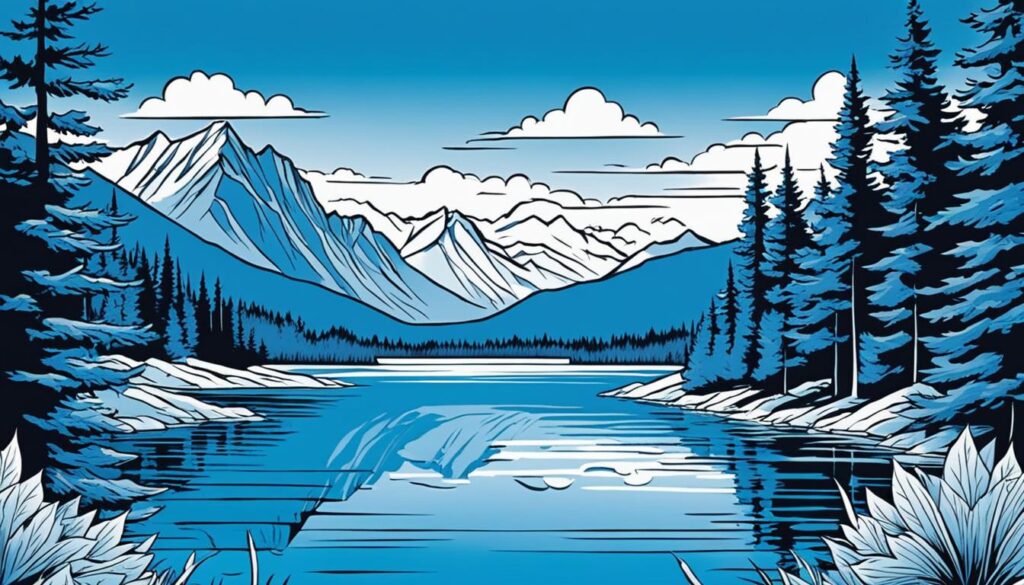 |
| Analogous | Colors that are next to each other on the color wheel, creating a harmonious and complementary palette. | |
| Complementary | Colors that are opposite each other on the color wheel, offering a high-contrast and visually striking combination. |  |
| Split Complementary | A variation of the complementary scheme, using a color and the two colors adjacent to its complement. |
https://www.youtube.com/watch?v=Cpvz9Ky7bHs |
| Triadic | Three colors that are evenly spaced around the color wheel, creating a vibrant and dynamic palette. | 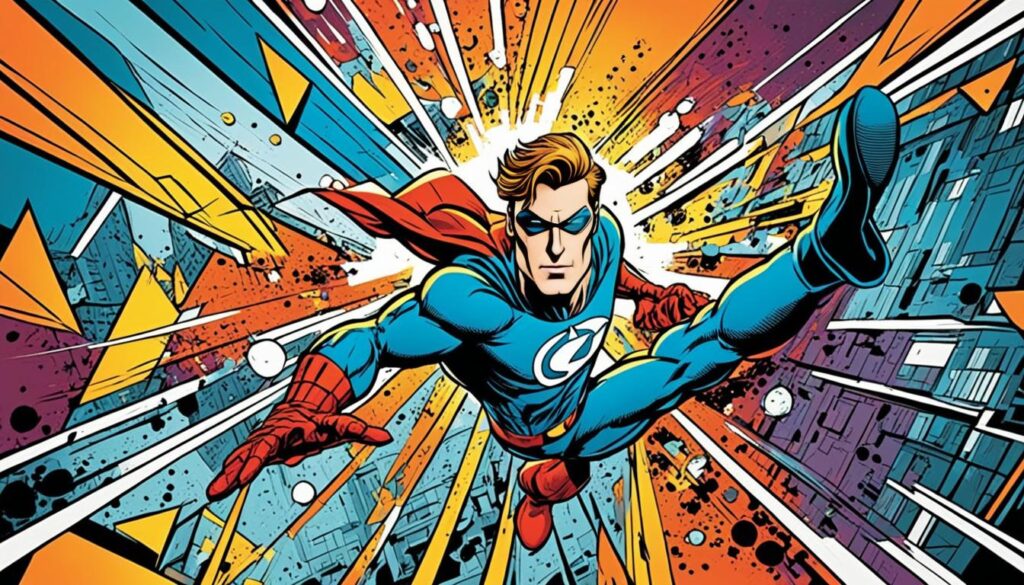 |
| Tetradic | Four colors that are grouped together on the color wheel, offering a rich and complex color scheme. |
Expressing Emotions Through Color
Color speaks volumes in anime and manga, especially for showing feelings. Warm colors like red, orange, and yellow reflect intense emotions such as love, anger, or joy. Cool hues like blue, green, and purple, however, give off a calm, sad, or mysterious vibe. When artists use these warm and cool colors together, they make their art stand out. They grab our attention and stir our emotions on a deeper level.
Warm and Cool Colors
Warm and cool colors are key in color and emotion in anime and manga. Warm tones express life, energy, and love, like the red of a beating heart. Cool shades, on the other hand, bring peace and thoughtfulness, like a quiet blue ocean. Artists play with these colors to make us feel what their characters are feeling. It’s a secret tool to draw us into their world.
Complementary Color Combinations
Complementary color combinations add even more depth to anime and manga emotions. For instance, putting red with its opposite, green, makes a scene pop. Or combining blue and orange brings a thrilling energy. These bold pairings create unforgettable moments in stories. They help us connect with the characters and feel their adventures more intensely.
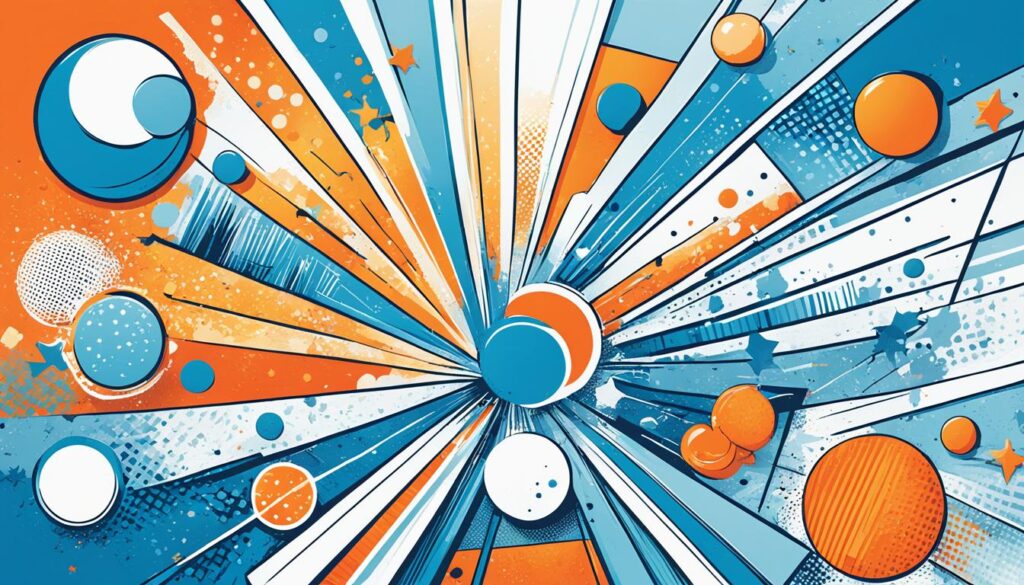
Character Design: Choosing the Right Colors
The colors in character design are key. They show a character’s personality, mood, and importance in the story. For instance, the shades of a character’s hair and eyes can hint at their personality. The colors of their clothes and accessories also reflect their status, feelings, or role in the story.
Hair and Eye Color Symbolism
Colors in hair and eyes tell us a lot about anime and manga characters. Natural colors might hint at down-to-earth personalities. In contrast, bright colors can show a link to supernatural elements or a leading role.
Eye color is just as important. Amber eyes often mean wisdom, while red or purple eyes can suggest mystery.
Clothing and Accessory Colors
What a character wears is another way to understand them. Characters dressed in warm colors may be energetic or bold. Those in cooler shades might be calm. The use of certain colors can also reveal a character’s job or story role.
Color is deeply meaningful in character design. Anime and manga creators use it to make their characters stand out and feel part of the story. This skill with color is a big reason behind the success of many well-loved works.
Environment and Background Coloring
In anime and manga, coloring the world is key. Artists pick color palettes that enhance the setting. This can be a lively city, a calm countryside, or a magical land. They use lighting and effects to add depth and mood. This draws viewers into the story’s world.
Matching Color Palettes to Settings
Research on environmental color design dates back to 1963. Studies by Frieling and others looked at colors’ impact. In 2003, AIC 2003 Bangkok focused on urban high visibility. There, Minah presented on blackness, whiteness, and color.
These studies connect with architects and researchers worldwide. They work to understand how color affects the environment.
Lighting and Atmospheric Effects
Colors influence how we think and feel in design. In design, red can mean passion or urgency. Recent work shows how colors in hospitals help kids. Color is vital in way-finding systems for guiding in complex places.
Color creates a special feel in places like Times Square. Graffiti’s colors express culture and identity. The color of a building is also important. It influences its design and how we remember it.
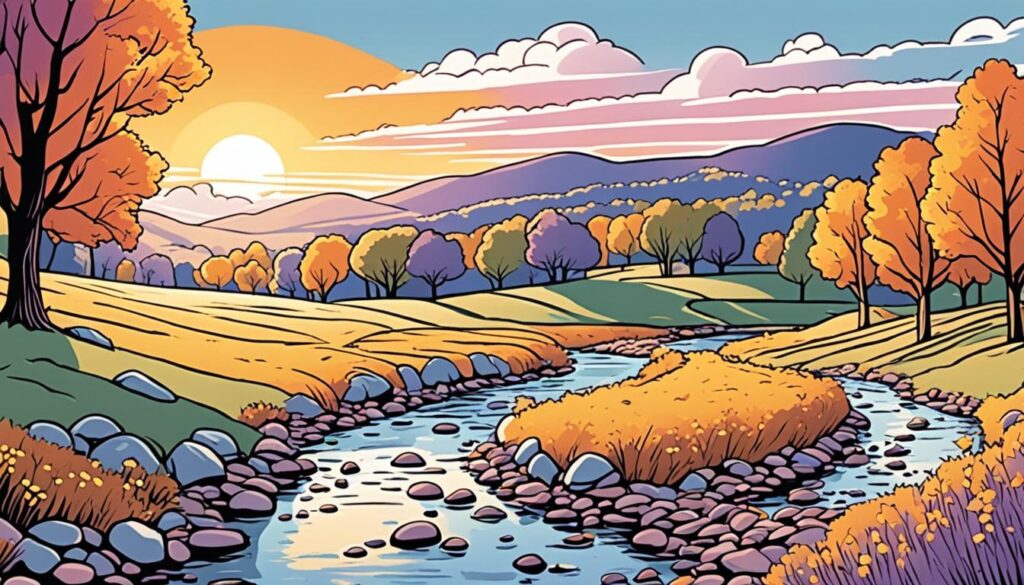
Color Palettes and Swatches
Anime and manga artists collect anime and manga color palettes and swatches. They do this to keep their work’s color consistent and aligned. This helps create the right feel and tell the story, showing differences between characters, places, and story parts. With a good set of color swatches for anime and manga, artists can easily add color that enhances the tale and looks good together.
| Key Statistics | Details |
|---|---|
| Used by 5+ million designers | Anime and manga color design tools are for many users, including pros and beginners. |
| Used by top companies | Big anime and manga studios use detailed color palettes to keep their quality high and consistent. |
| 5+ million users | Many in the anime and manga worlds use such tools, showing a growing need. |
| 20% commission on every purchase for affiliates | For those selling these tools, there are good benefits to promote them more, drawing in followers and fans. |
Take Paletton, for instance. It’s a well-liked digital tool for working with colors, suited for all levels of experience in anime and manga color projects. It encourages users to play with color palettes. This push for creativity and experimentation is key.
“Utilizing complementary color wheels can aid in selecting color schemes for artistic and design needs, such as website design, knitting projects, or interior painting.”
Paletton is praised for its help in finding the perfect color combinations for anime and manga. It makes finding the right colors very easy. Plus, it’s great for students of art or photography, helping them learn about different colors and how they work together.
Digital Coloring Techniques
In today’s digital world, many anime and manga artists are using advanced coloring techniques. They use color grading and adjustment tools to perfect the shades. Adding shading and highlights brings images to life. With these methods at hand, artists can create truly breathtaking artwork.
Color Grading and Adjustment
In an article about digital art, two paintings were made from the same sketch, each with a different color scheme. This shows how important color theory is for making art that stands out. The use of color swatches helps choose the right colors. It also mentions that the Eyedropper tool has limitations when selecting colors from photos due to pixel differences.
Layer-based Coloring
Starting with grayscale can help artists pick better colors. The article recommends this for drawings without a model. It also talks about using layer settings in Photoshop to control color intensity, offering many options for creativity.
Design Shading and Highlights
The article recommends beginning with only a few colors to learn color relationships. For those with more experience, it suggests using more colors for a challenge. It highlights the importance of contrast in drawing so that everything is clear. Tips like adjusting saturation can help make a piece of art really pop. In the end, trying different color schemes is key to improving.
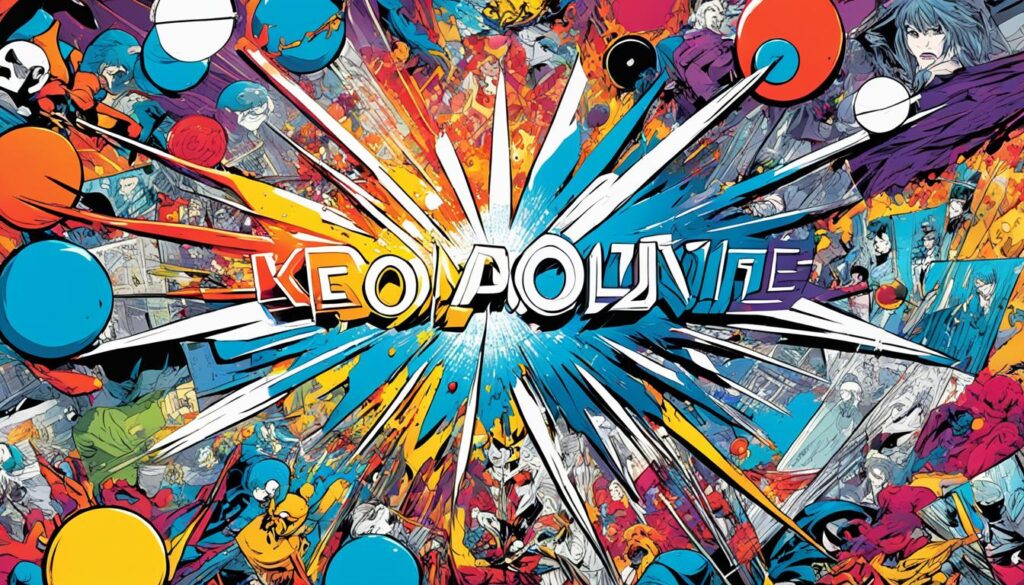
Traditional Coloring Methods
Digital coloring is common, but many artists still love traditional ways. They use watercolor, gouache, colored pencils, and markers. These bring a unique, personal feel to their work. Artists add flair with these methods.
Watercolor and Gouache Techniques
Watercolor and gouache make anime and manga art stand out. Watercolor’s light, flowing feel can be dreamlike. Gouache gives bold, vibrant textures. Artists use these to bring depth and emotion to their work.
Colored Pencils and Markers
Colored pencils and markers are precise. They help create strong, energetic lines. Using these tools boosts a piece’s dynamic feel and impact. They are key for manga and anime art.
Color Design in Popular Anime and Manga Series
Looking at the color design in anime and manga gives us great tricks to tell stories with color. For instance, Attack on Titan uses a dark color scheme to show sadness and fear. On the other hand, Naruto uses bright colors to show energy and fun. By seeing how these shows use colors, artists can pick up tips for their own work.
Case Study: Attack on Titan
Attack on Titan uses a dark and dull color scheme to match its gloomy world. The use of dark greys, blues, and browns makes you feel the lack of hope and fear against the Titans. However, bright reds and oranges are used in important scenes to show the story’s emotion and power.
Case Study: Naruto
Naruto, on the other hand, is full of life with its bright colors. It uses a lot of red, orange, and yellow to show the characters’ spirit. Blue and green colors are also seen, adding a magical touch and showing the characters’ special powers.
These anime examples help artists see how colors affect stories and emotions. These studies show the important part colors play in making anime and manga look amazing and feel deeply.
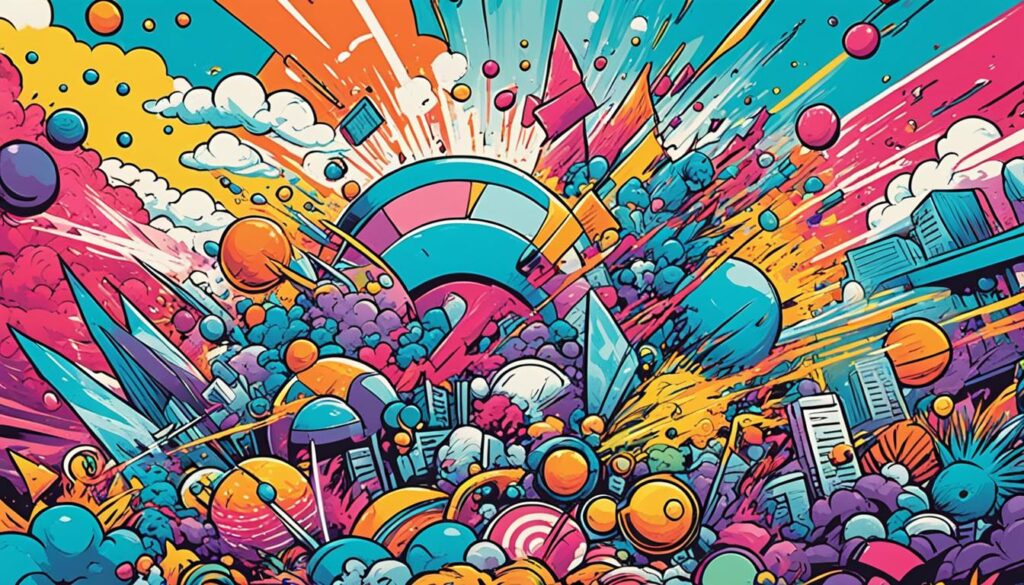
Color Meaning and Cultural Significance
Anime and manga are stories told through rich, cultural symbolism. For artists, knowing the color meaning and cultural significance is key. It helps them make art that everyone around the world can understand and enjoy.
Japanese Color Symbolism
In Japan, color symbolism comes from practices like Shinto and Buddhism. For example, red is about fire, passion, and goods. While white shows purity and blue is for peace and mystery.
Western Color Associations
Though, in the West, color association relies more on art, psychology, and culture. Blue is often a favorite. Yet, yellow might not be liked much. Red might mean love or power, depending on the context.
Through knowing these cultural differences in color meaning and symbolism, creators can reach a wide audience. They use color strategically in their anime and manga to tell stories that speak to everyone.
Trends and Future of Color Design in Anime and Manga
The world of anime and manga keeps changing, and colors play a big part in this. With new tech, artists are exploring more in color design than ever before. This lets them create unique looks with a mix of styles from all over the world.
What can we look forward to in color design in anime and manga? New designs like 3D textures and whimsical characters are getting popular. In the future, we might see old-school looks combined with metal texts and bright pastels. This mix is likely to set the trend for upcoming years.
For new artists, paying attention to these changes is key. It helps them stay ahead in creating eye-catching art. As anime and manga keep growing, knowing about color design will be really important for artists. It’s an exciting time to be part of this world.
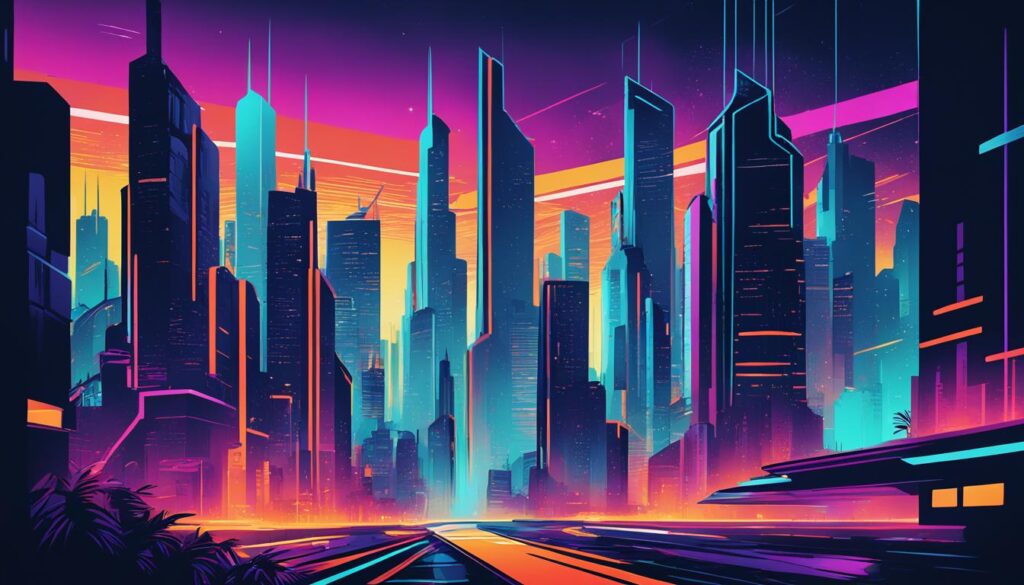
Resources for Color Design in Anime and Manga
Want to get better at picking colors for anime and manga? Lots of help is out there. This includes books, guides, online tips, and groups. All these offer plenty of info and support to help you get better at what you love.
Books and Guides
The “Anime & Manga Digital Coloring Guide” by Teruko Sakurai is a great start. It dives into many different digital coloring tricks.
These resources talk about everything you can think of in color design. From the basics of color theory to the newest digital coloring methods. They are helpful for artists no matter their level of skill.
Online Tutorials and Communities
The web is also full of color design knowledge for anime and manga. You can find videos and written guides to learn from. They help you get better and keep up with new trends.
Plus, there are lively online groups, like forums and social media. They let you show your art, get advice, and meet others who love the same things. This makes learning and growing as an artist even more fun.
With so many sources available, like books to online tips, anyone can master the art of color design. This could be the key to unlocking your creative genius.
Conclusion
Color design is key in anime and manga, enhancing stories and making characters stand out. Knowing color theory and how to show feelings with color helps artists a lot. Both traditional and digital coloring skills are important. They help artists grab their audience’s attention.
Color design is useful in many areas. It’s not just for anime and manga. Fields like education, law, medicine, ICT, business, and HR also benefit. Design thinking helps people use color to solve tough issues. It lets them connect with people and find new ways to help.
The world of anime and manga color design keeps growing. It pushes the limits of creativity and problem-solving. With strong color knowledge and storytelling skills, young artists can make their mark. They will shape the future of this exciting art form.
FAQ
What is the role of color in anime and manga storytelling?
Color in anime and manga tells us a lot. It helps show how characters feel. It also creates the places where the story happens. Different colors can make characters stand out or blend in.
How do the coloring techniques differ between manga and anime?
Manga, in books, uses a small range of colors. Anime, on screen, has more color. This makes anime more vibrant and exciting to watch.
What are the fundamental principles of color theory that anime and manga artists need to understand?
Artists need to know about colors. This includes the color wheel and different color types. Understanding this helps them create beautiful and meaningful pictures.
How can color be used to convey emotions in anime and manga?
Warm colors show strong feelings like love or anger. Cool colors, on the other hand, display calmness or sadness. So, colors can tell us a lot about how characters are feeling.
What role do color choices play in character design for anime and manga?
In anime and manga, character colors are very important. They tell us about the character’s personality. Colors in their clothes also share more about who they are.
How do anime and manga artists use color to create a cohesive visual identity for their works?
Artists keep detailed color records. This helps keep the same colors through the storyline. It makes the series feel complete and connected.
What are some of the digital coloring techniques used by modern anime and manga artists?
Today, artists use many digital methods. These include tools for light and shadow. They make the artwork more detailed and captivating.
How do traditional coloring methods influence the aesthetic of anime and manga?
Older methods like watercolor and markers add a special touch to anime and manga. They bring a unique beauty to the illustrations.
How do cultural differences in color symbolism impact the way anime and manga artists use color?
In Japan, color meanings have deep cultural values. This can change how colors are used in anime and manga. It’s different from what is found in Western art and culture.
What are some of the emerging trends and future directions in color design for anime and manga?
New technologies are changing how colors are used. Anime and manga now have a wider range of color choices. This creates more interesting and varied artwork.
Source Links
- https://blog.daisie.com/anime-manga-5-color-theory-enhancement-tips/
- https://www.ebay.com/itm/203107675705
- https://discover.therookies.co/2023/05/05/guide-to-creating-anime-style-characters/
- https://create.microsoft.com/en-us/learn/articles/what-is-color-theory
- https://99designs.com/blog/tips/the-7-step-guide-to-understanding-color-theory/
- https://www.artyfactory.com/color_theory/color_theory_3.htm
- https://www.gravitygroup.com/blog/conveying-emotions-colors/
- https://www.verywellmind.com/color-psychology-2795824
- https://dreamfarmstudios.com/blog/color-theory-for-character-design/
- https://www.clipstudio.net/how-to-draw/archives/156922
- https://characterhub.com/blog/character-resources/character-color-palette
- http://link.springer.com/content/pdf/10.1007/978-3-642-27851-8_235-7.pdf
- https://www.archdaily.com/1005862/the-strategic-use-of-color-in-environmental-graphic-design
- https://coolors.co/
- https://paletton.com/
- https://design.tutsplus.com/articles/two-techniques-for-applying-color-to-your-digital-paintings–psd-17993
- https://dribbble.com/stories/2020/04/28/choosing-color-for-illustration
- https://medium.com/@damodardmi0/fabric-dyeing-techniques-from-traditional-to-modern-approaches-b733ec74551
- https://aic-color.org/resources/Documents/jaic_v32_03.pdf
- https://www.designcuts.com/learning-hub/articles/how-manga-and-anime-inspired-designs-are-taking-over-the-world
- https://www.animeoutline.com/beginner-guide-to-picking-colors-when-drawing-anime-manga
- https://www.smashingmagazine.com/2010/01/color-theory-for-designers-part-1-the-meaning-of-color/
- https://www.interaction-design.org/literature/topics/color-symbolism
- https://medium.com/samurai-cory-draws/character-design-and-worldbuilding-adb523e2190a
- https://red-website-design.co.uk/18-graphic-design-trends-for-2024-the-future-of-creativity/
- https://www.instructables.com/How-to-digitally-color-your-manga-anime-or-comic-/
- https://resourceanime.tumblr.com/
- https://www.tutorialspoint.com/design_thinking/design_thinking_conclusion.htm
- https://academic.oup.com/book/9696/chapter/156838614
